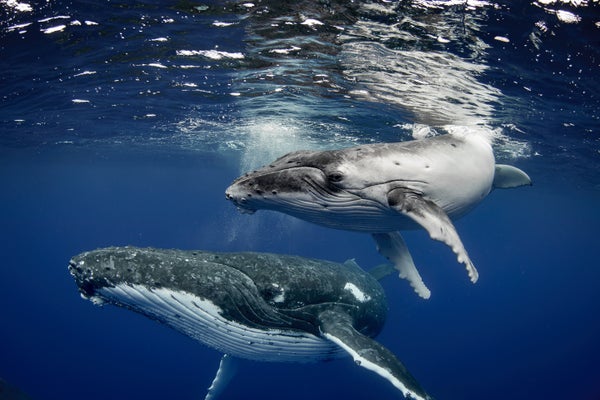www.scientificamerican.com
February 6, 20254 min readWhale Songs Obey Basic Rules of Human LanguagesHumpback whales learn their haunting melodies in much the same way humans learn wordsBy Cody Cottier edited by Andrea ThompsonJohn Natoli/Getty Images For all the worlds linguistic diversity, human languages still obey some universal patterns. These run even deeper than grammar and syntax; theyre rooted in statistical laws that predict how frequently we use certain words and how long those words tend to be. Think of them as built-in guardrails to keep language easy to learn and use.And now scientists have found some of the same patterns in whale vocalizations. Two new studies published this week show that, despite the vast evolutionary distance between us, humans and whales have converged on similar solutions to the problem of communicating through sound. It strengthens the view that we should be thinking about human language not as a completely different phenomenon from other communication systems but instead think about what it shares with them, says Inbal Arnon, a professor of psychology at the Hebrew University of Jerusalem and a co-author of one of the studies.Arnon and her colleagues, whose paper was published on Thursday in Science, analyzed eight years of humpback whale song recordings from New Caledonia in the South Pacificand found that they closely adhered to a principle called Zipfs law of frequency. This mathematical-power law, a hallmark of human language, is observed in word-use frequencies: the most common word in any language shows up twice as often as the second most common, three times as often as the third most common, and so on.On supporting science journalismIf you're enjoying this article, consider supporting our award-winning journalism by subscribing. By purchasing a subscription you are helping to ensure the future of impactful stories about the discoveries and ideas shaping our world today.Listen to the humpback whale songs:But before they could analyze the recordings, the researchers had to identify the segments that were analogous to words (though, importantly, without semantic meaning) in a stream of otherworldly grunts, shrieks and moans. They found themselves in the same predicament as a newborn babyso naturally, thats where they turned for guidance. Human infants get this continuous acoustic signal, Arnon says, and they have to figure out where the words are.A babys strategy is simple: listen for unexpected combinations of sounds in adult speech. Whenever you identify one, youve probably located a boundary between word, because those uncommon transitions are less likely to occur within words.Incredibly, humpbacks may be using the same approach. When the researchers segmented whale songs based on these transitional probabilitiesjust as a human infant wouldthey fit Zipfs law of frequency like a glove. On the other hand, 1,000 arbitrarily shuffled elements of the data came nowhere near a match, strongly suggesting the transitional probability results werent a product of random chance.We were all dumbfounded, says co-author Ellen Garland, a whale song expert at the University of St. Andrews in Scotland. There was the possibility of discovering these same structures. Did we think we would? Hell no.Why would the same communicative behaviors evolve independently in whales and humans, whose last common ancestor was a shrewlike creature that lived roughly 100 million years ago? Well, distribution of words according to Zipfs law of frequency, or Zipfian distribution, seems to help infants grasp language. When things are organized that way in your input, youre going to learn them better, says Simon Kirby, a cognitive scientist at the University of Edinburgh and a co-author of the new Science paper.In other words, the structure of language is largely a product of how it gets passed from one generation to the next. So the team reasoned that Zipfs law of frequency might appear not just in humans but also anywhere else sequential vocal signals are culturally learned (transmitted from one individual to another). That group includes what Kirby calls a strange, ragtag bunch of species, including songbirds, bats, nonhuman primates, elephants, seals, dolphins and whales. Pretty much all other animals that communicate vocallyfrom dogs to frogs to fishare believed to do so through signals that are genetically programmed, not learned.We now know that whales, at least, share a key ingredient of our own communication system, a finding that fits with the growing attitude among scientists that we arent as unique as we once thought. Rather our linguistic capacity rests on a smorgasbord of physical and cognitive traits, many of them spread throughout the animal kingdom.In a separate paper published in Science Advances on Wednesday, Mason Youngblood, a postdoctoral fellow at Stony Brook University, found evidence of two more such traits in whale vocalizations: One was the brevity law, which, when applied to human language, states that the more common a word is, the shorter it tends to be, and vice versa. The other was Menzeraths law, which says that the longer a linguistic construct (such as a sentence) is, the shorter its constituent parts (such as a sentences clauses) will be.Both patterns were especially strong in humpback song, and both showed up in various other species as well. These laws are all about efficiency. They describe how animals maximize the amount of information they convey in the least amount of time and with the least amount of energy, Youngblood says.As tempting as the comparisons with human language may be, the researchers caution against reading too much into these parallels. Whale song is not a language, Garland says flatly, noting that most experts agree that the animals words dont carry semantic meaning. (Neither does music, for that matteryet Zipfs law of frequency appears there, too.)As far as the similarities go, though, they are striking. Luke Rendell, a biologist at the University of St. Andrews, who was not involved with either study, believes these findings could be telling us something kind of profound about how evolution can either converge at or, perhaps, be constrained to certain types of learning. That is, they could be informing us about the range of possibilities for complex communication in any species.By the same token, Kirby suggests that Zipfs law of frequency (and perhaps other linguistic laws) could be a kind of fingerprint of these culturally evolved systems, present wherever animals have crossed the threshold of cultural learning. Its probably a very fundamental feature of the organization of cognitive systems, he adds.












